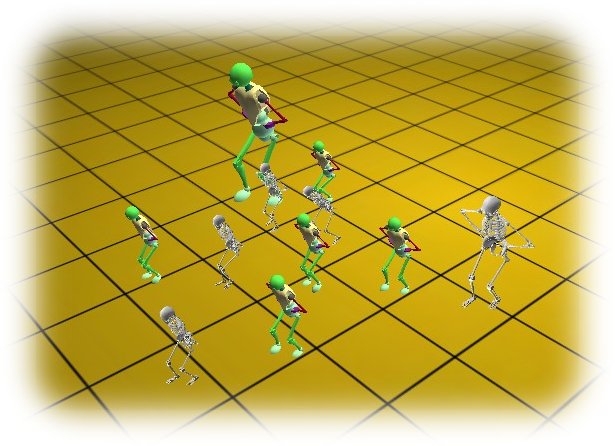Morphological and stance interpolations in database
for simulating bipedalism of virtual humans
| Nicolas Pronost | Georges Dumont | Gilles Berillon | Guillaume Nicolas |
| University of Rennes 1 | ENS Cachan | UPR 2147 | University of Rennes 2 |
| IRISA - SIAMES | IRISA - SIAMES | CNRS | M2S Laboratory |
Abstract :
We present a computer tool for testing walk hypotheses for human beings. This tool aims to generate plausible walking movements according to anatomical knowledge. To this end, we introduce an interpolation method based, on one hand, on morphological data and, on the other hand, on stance hypotheses and on footprint hypotheses. We want to test these hypotheses for application to the reconstruction of early hominid walking. We interpolate from a specific representation of the movement a characteristic relative displacement. First, we use a motion capture system to acquire real movements of a walk cycle, and we propose to represent them by using a generic parametric model. Thus, we create a database of movements. The interpolation process produces, thanks to this database, a retargeted motion adapted to the morphology of the considered targeted skeleton. The interpolation is done according to three main hypotheses. The first concerns the reference stance, the second the lateral spacing between the feet, and the third the length of the step. In the introduction, we refer to related work. Then we propose the two following points of our method: the 3D representation of our motion representation and the multidimensional interpolation method applied to this representation. The interpolation method addresses morphological adaptation, and the use of an inverse kinematics solver addresses the computation of skeleton movements. The self-coherent validation process aims to test the coherence of the proposed method. The results propose an application to a virtual skeleton of Lucy (Australopithecus afarensis A.L. 288-1) reconstructed from real data. Finally, the relevance of the method for anthropological investigations and for animation purposes is discussed and future work is discussed with respect to the limitations of the proposed method.
Keywords :
Motion retargeting - Biomechanics - Bipedalism - Morphological and multidimensional interpolations - Virtual human
Paper :
Author-created version :
The original publication is available at www.springerlink.com
BibTeX :
@article{PDBN06,
author = {N. Pronost and G. Dumont and G. Berillon and G. Nicolas},
title = {Morphological and stance interpolations in database for simulating bipedalism of virtual humans},
journal = {The Visual Computer},
year = {2006},
volume = {22},
number = {1},
pages = {4-13},
month = jan,
publisher = {Springer-Verlag GmbH},
series = {0178-2789},
doi = {10.1007/s00371-005-0350-y}
}
Video :
Combining morphological interpolation and biomechanical inverse kinematics to simulate bipedal locomotion. Presentation of the retargeting technique and the inverse kinematics solver through 2 examples.
The three following videos show locomotions generated by our kinematical adaptation algorithm.
Adapted to blend styles (left) and normal erected styles (right).
Adapted to small lateral shifting steps (left) to largest ones (right).
Adapted to large step sizes (left) to smallest ones (right).
This video presents a plausible walk motion adapted to the Australopithecus Afarensis "Lucy". Paleoanthropological data are used to produce this locomotion.
